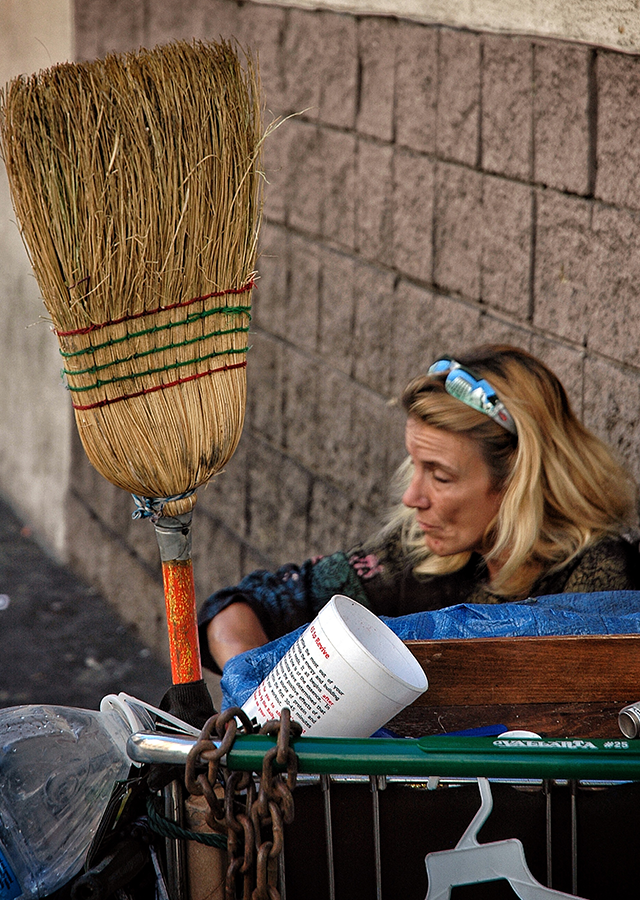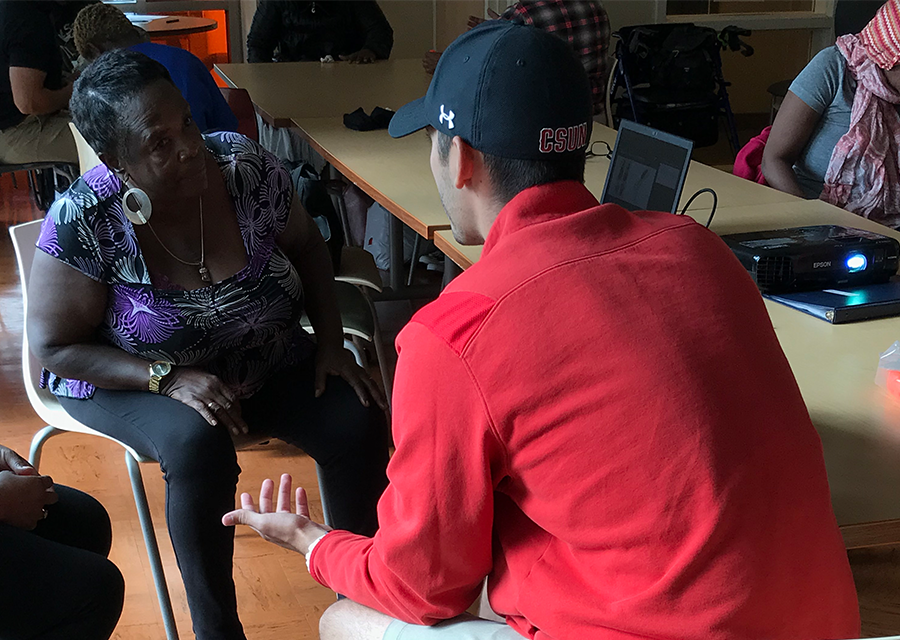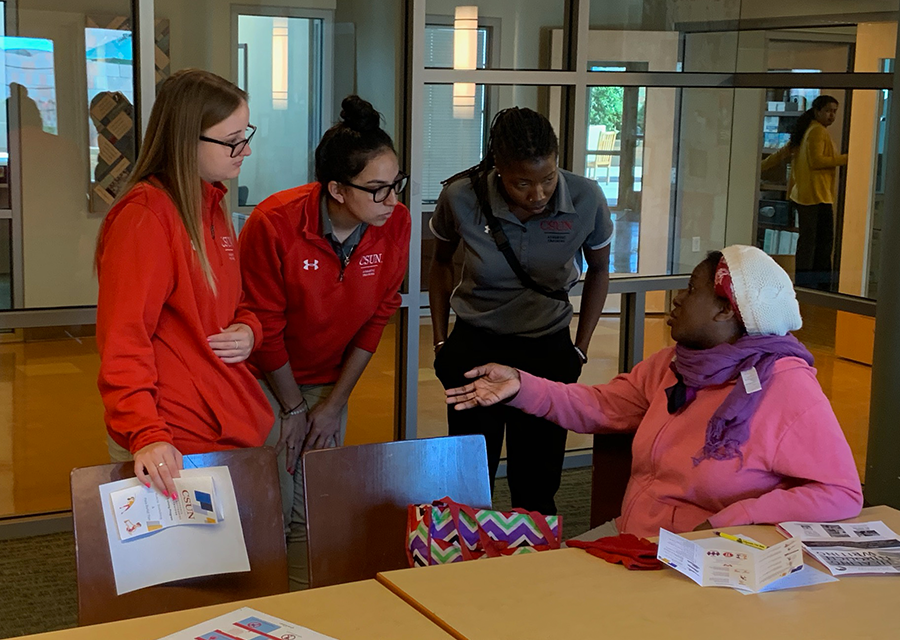‘These Ladies Are in Pain’: On Skid Row, CSUN Athletic Training Students Ease Homeless Women’s Pain

A homeless woman poses for a photo on Skid Row in 1994. Photo courtesy of CSUN journalism professor David Blumenkrantz.
Denise Smith was on her feet all day, often missing sleep as she hungrily searched for a fix, carrying a worn backpack filled with everything she owned — a spare pair of shoes, a change of clothes and bottles of water — enduring this every day for years, often with no place to rest her head or set down her belongings.
This lifestyle took a grave toll on her body.
Over years, damage and trauma built up in her knees, ankles, back, neck and hips. At the medical clinics that would see her, Smith was prescribed pain relievers, and told she needed physical therapy and surgery, which she couldn’t afford. For some time, she turned to drugs, alcohol and whatever food she could get her hands on to ease the aching, which only added extra weight on her body for her to carry.
After overcoming her drug addiction eight years ago, Smith learned that these “remedies” had only been masking the pain.
“When I stopped, I felt it,” she said.
Every Day is Physical
By then, she knew she needed help.
She found it at the Downtown Women’s Center, which offers women living on Los Angeles’ Skid Row a variety of services, including medical and mental health consultations. Now a peer leader for health workshops at the center, she said she has met many women who have shared her suffering: They’ve had to carry belongings all day, stand and walk for hours, and sleep on concrete.
Spencer Coats, the center’s director of health and wellness, surveyed his clients in 2018 to get a better idea of the challenges they face, and was startled to learn that so many women experiencing homelessness were struggling with pain and injury to their muscles and joints.
“There’s a wider issue here that’s been overlooked,” he said. “These ladies are in pain, and they want to know what to do about it.”
This new awareness led Coats to a crucial question: Who fixes this problem for women who are unhoused?

A homeless woman rests on Broadway in Downtown Los Angeles. Photo courtesy of David Blumenkrantz.
As fate would have it, the answer was close to home — and it led to CSUN. Coats’ partner, Sean Rogers, is an assistant professor of athletic training in CSUN’s College of Health and Human Development. Rogers volunteered his expertise and his students to address and educate about these injuries for the residents of the Downtown Women’s Center.
Athletic trainers are health care professionals who most often work with professional, college and high school sports teams — evaluating, diagnosing and creating intervention and rehabilitation plans for patients who suffer from musculoskeletal injuries. However, CSUN’s athletic training faculty and students look for opportunities to serve local populations who lack access to proper health care services, Rogers said. For example, Rogers has offered services to national organizations serving LGBTQIA+ individuals, who sometimes choose not to seek health care due to fear of discrimination in clinics.
Women experiencing homelessness were a natural fit for athletic trainers.
“These ladies are technically ‘nontraditional athletes,'” Coats said. “Their everyday experiences are tremendously physical, except instead of the 100-meter dash, they’re doing the 5-mile suitcase carry.”
Preventing and Soothing
In its most recent annual count in August, the Los Angeles Homeless Services Authority reported 58,936 residents who are experiencing homelessness in Los Angeles County.
Deteriorating health is often a consequence of homelessness. Individuals rarely have time to rest and stretch their legs or massage their muscles, Coats said.
Marrying this problem with a viable solution within their arsenal, in fall 2018 CSUN athletic training students offered their first workshop at the center, covering tips and techniques for preventing and alleviating common injuries to bones, muscles and joints.

A CSUN student volunteer speaks with Denise Smith at the Downtown Women’s Center. Photo courtesy of Sean Rogers and Spencer Coats.
This fall, CSUN students — with Rogers’ guidance — developed three separate sessions for the Downtown Women’s Center with pain prevention and mitigation tips, each focusing on a specific region of the body. The first, on Oct. 14, focused on the lower leg and ankle. The second, on Nov. 13, covered the hips and lower back. A session on Dec. 9 will address the shoulder, elbow and wrist.
Each session begins with an interactive lecture, in which students share information about bone, muscle and joint issues — and then demonstrate stretches, postures and exercises to soothe specific pains. After the lecture, students provide one-on-one counseling to attendees and provide education to their health concerns.
New Approaches to Health Care
Major differences between working with women experiencing homelessness and with athletes involve the cause, the history and the context of the patients’ injuries, the students said.
“Since we’re dealing with a population that we don’t typically deal with, this experience really challenges us to think outside the box,” said Artturi Simila, a senior in the athletic training program who volunteers his time at the workshops.

Three CSUN student volunteers listen to a woman at the Downtown Women’s Center. Photo courtesy of Sean Rogers and Spencer Coats.
He said that he and his fellow students not only had to learn new approaches to health care, but also had to use language that was clear and simple enough to be understood by individuals who aren’t used to being around health care professionals.
Student volunteer Fatou Sy initially was drawn to taking up athletic training because she wanted to support athletes, having participated in multiple sports herself, she said. However, opportunities like this one reminded her of other populations she also hopes to serve.
“One of the main things that I want to do in life is help people experiencing homelessness,” Sy said, “and they usually don’t have [athletic trainers] or even nurses to go to.”
Athletic training student Michael Nam said providing the workshops felt “a little like small victories” for the community.
“The Highest Quality of Life Possible”
The primary benefit of the program to the women served is health education, Rogers said.

CSUN athletic training students give an educational presentation during a workshop session at the Downtown Women’s Center. Photo courtesy of Sean Rogers and Spencer Coats.
“Even after they are no longer homeless and they achieve permanent housing, the health detriments that have occurred prior to or during their time experiencing homelessness stay with them,” he said.
Learning how to care for their bodies may help more women avoid developing long-term conditions, such as osteoarthritis, tendinopathies (pain and swelling in the tendons) and other forms of chronic pain in muscles and joints, that often arise from years of improper movement patterns and a lack of access to basic needs and quality health care, he added.
So far, the 2019 sessions have drawn a full house of attendees. “We saw a lot of familiar faces [from last year’s workshop],” Simila said. “That was pretty cool to see — they were really excited about the upcoming classes that we’re going to do, too.”

Professor Sean Rogers (far right, back row) and his athletic training students with women from the Downtown Women’s Center. Photo courtesy of Sean Rogers and Spencer Coats.
In the future, Rogers said, the Athletic Training Program would like to establish a more permanent presence at the Downtown Women’s Center where faculty and students can offer ongoing athletic training services to women there, ranging from education to diagnosis and rehabilitation.
“We want to give them all the tools that we can, to help them experience the highest quality of life possible,” Rogers said. “Of course, there are a lot of other factors that go along with that, but this is our small piece of the puzzle — to help.”
For Smith, choosing to seek help with her pain was a crucial stride in seeing positive changes happen in her life.
“I was in this situation, but I got out of it,” she said. “The start of freedom is being able to say, ‘I am hurting. Help me.'”
About David Blumenkrantz’s Photos
CSUN journalism professor David Blumenkrantz provided photos from his One of Us project, which features both environmental portraits and candid images of the lives of the homeless through a collaboration with the San Fernando Valley Rescue Mission. The objective was simply to “change the conversation” about homelessness by providing a platform for self-representation, engaging anyone interested in sitting for a portrait and sharing their thoughts in a recorded interview session. The One of Us Project is currently running a “How We See It” photography workshop that involves CSUN students mentoring homeless people in photography. An exhibition of the “How We See It” project will be displayed at the Museum of Social Justice in January.

 experience
experience